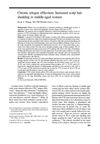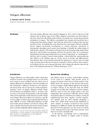Search
for
Did you mean Telogen Ratio?
Learn
5 / 19 resultslearn Fluridil
a topical anti-androgen with less systemic involvement
learn Thymosin Beta 4
learn Osteopontin
signaling protein that, when suppressed, may grow hair by reducing inflammation and stem cell loss
learn Beta Polypeptide
Research
5 / 1000+ results
research Effects of Platelet-Rich Plasma on Hair Follicle Count and Hair Ratios in Androgenic Alopecia: Alone or Combined with Other Treatments
PRP improves hair growth in androgenic alopecia, especially when combined with minoxidil.

research The Reliability of Horizontally Sectioned Scalp Biopsies in the Diagnosis of Chronic Diffuse Telogen Hair Loss in Women
Horizontally sectioned scalp biopsies are more reliable for diagnosing hair loss in women when three samples are taken instead of one.

research Chronic Telogen Effluvium: Increased Scalp Hair Shedding in Middle-Aged Women
Middle-aged women with chronic telogen effluvium experience increased hair shedding but usually don't get significantly thinner hair.

research Telogen Effluvium: Causes, Diagnosis, and Treatment
Telogen effluvium is a common type of hair loss that can resolve on its own or become chronic, with treatment depending on early diagnosis.

research Chronic Telogen Effluvium: Is It a Distinct Condition? A Systematic Review
Chronic telogen effluvium may not be a unique condition and could be confused with other types of hair loss.
Community Join
5 / 619 resultscommunity How dutasteride makes hair loss impossible
Dutasteride is discussed as a treatment that makes hair loss impossible, with some users sharing experiences of hair regrowth and side effects. Finasteride and oral minoxidil are also mentioned as treatments, with concerns about side effects and effectiveness.
community Predict if You'll Shed and Responding to Treatment: Ultrasound Imaging Technology
Ultrasound imaging can predict hair shedding and assess hair growth stages by analyzing hair follicle characteristics. The conversation also discusses using ultrasound for personal hair analysis and mentions the potential use of infrared emission for hair treatment.
community Summary of Procapil video by Haircafe
Procapil is marketed as a natural hair loss treatment but lacks strong evidence and is industry-biased. Minoxidil and Finasteride are the only FDA-approved treatments for androgenetic alopecia.
community Yes your lifestyle and diet has its role in hair loss.
Diet and lifestyle changes can reduce hair shedding but won't regrow hair lost to genetic male pattern baldness. Treatments like finasteride and dutasteride are necessary for significant hair regrowth.
community How I recovered from 4+ years of severe balding ages 20-24 by dieting, lifestyle changes and ONLY using topical minoxidil
A user reversed severe hair loss with dieting, lifestyle changes, and topical minoxidil, highlighting reduced inflammation and body fat. The conversation debates finasteride's effectiveness and the impact of diet and lifestyle on hair health.